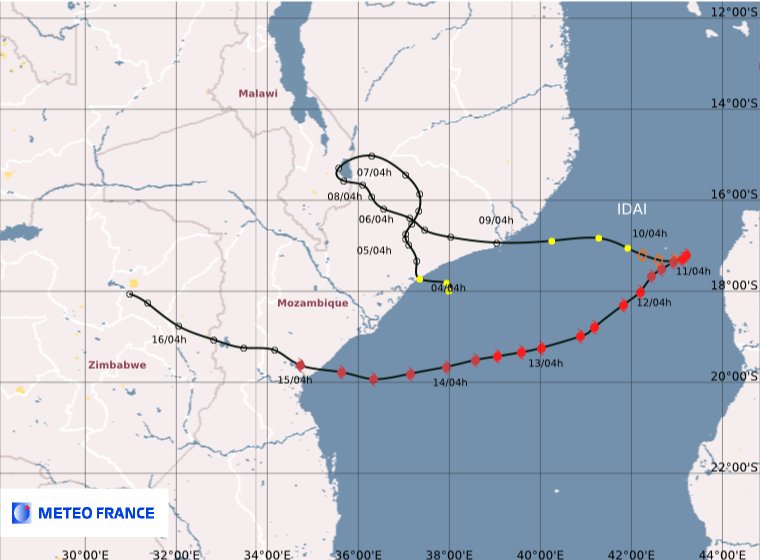Cyclone Idai bounces back & forth in Mozambique canal
Sentinel-3 SLSTR RBT acquired on 03 March 2019 at 06:46:34 UTC
...
Sentinel-5P TROPOMI CLOUD acquired on 09 March 2019 at 09:58:25 & 11:38:26 UTC
Sentinel-3 SRAL LAND acquired on 10 March 2019 at 06:38:00 UTC
Sentinel-1 CSAR EW acquired on 11 March 2019 at 02:43:10 UTC
Sentinel-3 SLSTR RBT acquired on 21 March 2019 from 06:40:49 to 07:20:14 UTC
...
Sentinel-5P TROPOMI CLOUD acquired on 09 March 2019 at 09:58:25 & 11:38:26 UTC
Sentinel-3 SRAL LAND acquired on 10 March 2019 at 06:38:00 UTC
Sentinel-1 CSAR EW acquired on 11 March 2019 at 02:43:10 UTC
Sentinel-3 SLSTR RBT acquired on 21 March 2019 from 06:40:49 to 07:20:14 UTC
Keyword(s): Natural disaster, emergency, hurricane, wind, precipitations, flooding, Madagascar, Malawi, Zimbabwe

Track followed by cyclone Idai until the 16.03.2019 - Source: Météo-France
This images selected in this story are dedicated to showcase the capacity of the Copernicus program to follow closely a cyclone anywhere in the World. While the resulting impact on human lives and tremendous damage will be touched upon in this event sheet, images showing the consequences of Cyclone Idai will shown in following stories.
Following the devastation caused by Cyclone Idai, Mozambique mobilized all its staff to secure and help the population. The African Park rangers published a newsletter asking for the support of their collegues in Mozambique where they summed up the situation: "Mozambique has declared a state of emergency following the devastation wreaked by the strong Category 2 Cyclone Idai, which made landfall near Beira, its second largest port, on the 14th of March. An unprecedented humanitarian crisis is evolving, with floods of up to six metres consuming 3,000 square kilometres of densely populated landscape. An inland ocean now covers land 25 kilometres from the coast."
"In the immediate aftermath of the storm, the death toll is expected to surpass 1,000 people, but the UN estimates that about 600,000 in Mozambique alone will be affected. Tens of thousands of people have lost their homes, while roads and bridges have been washed away and communication and power supply have been severed."
"While thousands seek refuge, waiting for rescue, food, clean drinking water and medical aid, further heavy rains and high tides are expected to exacerbate the situation. Rescue and relief efforts are overwhelmed and severely constrained, with more people, equipment and resources required."
ACAPS (Assessment Capacities Project), an independant organisation partly funded by the EU, accessed the damage in each country damaged by Cyclone Idai. The flooding reached Malawi soon as alerted the introduction of a first bulletin: "Heavy rains over 5-8 March caused flooding in the Southern region of Malawi."
A later report details further: "Since the publication of the ACAPS Malawi Floods Briefing Note on 12 March, severe flooding has continued in southern and central regions of Malawi. In total, an estimated 922,900 people have been affected across 14 districts, with 56 deaths and 577 injuries reported and more than 125,000 displaced. The number of people reported as being affected by flooding has increased by more than 450,000 since the last ACAPS report. This trend can likely be attributed in part to the impact of Cyclone Idai, which has exacerbated rainfall across Malawi, and potentially to new information becoming available. Response gaps include shelter, food, health, and WASH. There is an elevated risk that rain linked to Tropical Cyclone Idai will persist in southern and central regions of Malawi, which will likely continue to drive humanitarian needs in flood-affected areas."
The excess water runoff went downstream of Malawi, flooding Mozambique, Cyclone Idai came back with full hitting Mozambique. ACAPS evaluated the situation of Mozambique on the 19.03.2019: "Tropical Cyclone Idai made landfall on the evening of 14 March, on Beira city (Sofala province) in central Mozambique. Reports estimate that 600,000 people in Sofala, Zambezia, Tete, Niassa, Manica and Inhambane provinces have been affected and are in need of humanitarian assistance. So far 150 people are reported dead (including 66 due to flooding before the cyclone impact) and more than 1,500 injured, with the toll expected to increase in the coming days. Prior cyclone-related flooding had already displaced 17,000 people and very likely thousands more were displaced after the cyclone passage. Houses, health, and education facilities have been severely damaged in the provinces affected, particularly in and around Beira. Extensive damage to livestock and planted crops has also been reported."
Finally, after adventuring far onshore, Idai also caused extreme precipitations over Zimbabwe where it caused important loss of lives and large destructions as reported ACAPS: "Tropical Cyclone Idai hit eastern Zimbabwe with heavy rains and strong winds on 15-16 March. Manicaland and Masvingo provinces are mostly impacted, facing massive destructing caused by floods and landslides. An estimated number of 12,500 to 15,000 people have been affected overall, with at least 9,600 people (1,600 households) in the hardest hit districts, Chimanimani and Chipinge (Manicaland province). As of 18 March at least 82 people have died, 200 people are injured, thousands are displaced, and many properties, crops and livestock have been damaged and destroyed. More than 200 people are still missing. Assessments are on going and numbers are likely to increase. Priority needs are shelter, WASH, food, livelihood, and health assistance."
















